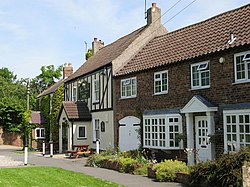Kirklington, Yorkshire: Difference between revisions
Created page with "{{Infobox town |name=Kirklington |county=Yorkshire |riding=North |picture=Kirklington Village - geograph.org.uk - 1319553.jpg |picture caption=Kirklington Village |os grid ref..." |
(No difference)
|
Latest revision as of 20:20, 27 August 2023
| Kirklington | |
| Yorkshire North Riding | |
|---|---|
 Kirklington Village | |
| Location | |
| Grid reference: | SE319810 |
| Location: | 54°13’27"N, 1°30’44"W |
| Data | |
| Population: | 220 |
| Post town: | Bedale |
| Postcode: | DL8 2 |
| Local Government | |
| Council: | North Yorkshire |
| Parliamentary constituency: |
Richmond (Yorks) |
Kirklington is a village in the North Riding of Yorkshire, close to the A1(M) motorway.
The population of the parish in the 2011 UK Census was recorded as 315 together with the parishes of Howgrave and Sutton with Howgrave.
The public house in the village is the Black Horse. On the edge of the village is a cricket pitch used by the village team.
History
A neolithic burial mound known variously as 'Stapler's Mound' or 'Stapley Mound' lies between the village and the A1(M) motorway.
There is some evidence of Roman occupation around the village, in the form of a white-ware burial at the Lady well, a stretch of Healam Beck, behind the Hall. Also close to the village on the A1(M), at Healam Bridge lie buried the remains of a Roman Dere Street fort, almost entirely ploughed away. Just beyond the village to the north lies 'Camp Hill', the remains of an Iron Age camp.
Kirklington is recorded in the Domesday Book as Cherdinton alongside Yarnwick, a lost village whose remains lie to the north of the village, between the Hall and Camp Hill prehistoric sites.[1] The principal landowner at the time was Count Alan of Brittany.[2] At the time of the Norman invasion the Lord of the Manor was Rosskell, but the title was granted by the Crown to Robert of Moutiers.
The Anglicised form of Moutiers was Musters and this family held the manor until the mid 14th century, when is passed via marriage into the Wandesforde family. The line of succession was not a complete one thereafter, but the name was continued by those marrying into the family who adopted the Wandesford surname.

The Hall, which stands in Whinwath Lane on the northern edge of the village, was built around 1570 for Sir Christopher Wandesford, with alterations in the early 18th and 19th centuries. It is a Grade II* listed building.[3]
There was a school house, now converted to housing, that served the village until the 1970s.[4]
Many of the village's houses are still owned by the estate.[1][5]
There are three known ghost stories about the village, one in the pub, one in the Hall and one around Stapley Lane.

Parish church
The parish church in the village is dedicated to St Michael. It was built in the 13th century with subsequent restorations and contains banners and armour of the Wandesford family who still own the Hall. It is a Grade I listed Building.[6]
Outside links
| ("Wikimedia Commons" has material about North Yorkshire Kirklington, Yorkshire) |
References
- ↑ 1.0 1.1 A History of the County of York: North Riding - Volume 1 pp 371-377: Parishes: Kirklington (Victoria County History)
- ↑ Kirklington, Yorkshire in the Domesday Book
- ↑ National Heritage List 1315187: The Hall (Grade II* listing)
- ↑ "School closure". http://hansard.millbanksystems.com/commons/1970/mar/26/schools-wath-and-kirklington-closure. Retrieved 3 January 2013.
- ↑ National Heritage List 1016265: Round barrow 250m north east of Comer Lodge
- ↑ National Heritage List 1150766: Church of St Michael (Grade I listing)
